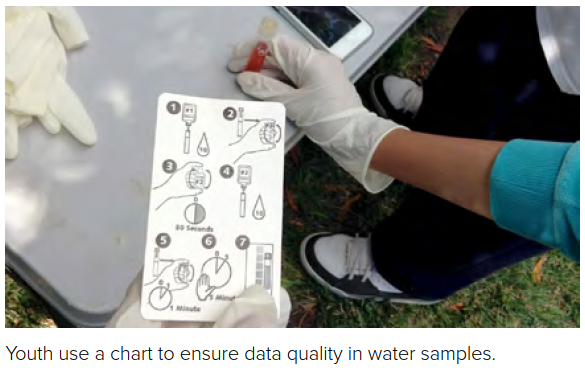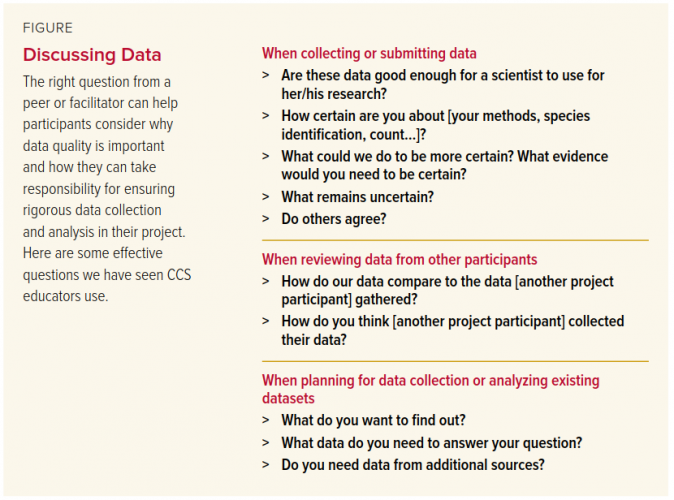Brief: Youth Ownership of Data Quality
Download a pdf version of this Research Brief
We’ve found that giving young people responsibility for ensuring high-quality data collection and analysis positions them as responsible experts and encourages investment in the process and products of science [1]. Through community and citizen science (CCS), scientists can answer questions in ways possible only through collaboration with public participants, yet scientists express concern over data quality, particularly when working with young people. However, young people can understand scientific data collection standards, and collect high-quality data, sometimes more reliably than adults [2].
Why it’s good for learning
 By assuming responsibility for data
quality, youth can develop ownership of, and investment in, their
scientific work [1]. Youth participants can become frustrated by
repetitive data collection when they don’t understand the
rationale or have little autonomy in how the data are
collected[3]. It is important that young people experience CCS
activities as meaningful and not simply as rote work [4].
Extensive research shows that a strong sense of ownership of the
work is associated with more active engagement, increased sense
of agency and self-efficacy, positive attitude toward science,
and improved science learning outcomes [5,6].
By assuming responsibility for data
quality, youth can develop ownership of, and investment in, their
scientific work [1]. Youth participants can become frustrated by
repetitive data collection when they don’t understand the
rationale or have little autonomy in how the data are
collected[3]. It is important that young people experience CCS
activities as meaningful and not simply as rote work [4].
Extensive research shows that a strong sense of ownership of the
work is associated with more active engagement, increased sense
of agency and self-efficacy, positive attitude toward science,
and improved science learning outcomes [5,6].
In our research [ 1], we saw educators foster youth responsibility for data quality by: (a) encouraging individual students to accurately calibrate instruments and ensure that peers were correctly measuring and inputting results; (b) facilitating conversation between students and scientists, managers, and the public that prompted students to think through the strength of their evidence and relationship to claims; (c) making youth aware of other CCS project participants including students, community members, or scientists; and (d) having students develop their own questions for analysis, alongside those of the broader project.
Youth explained that they took up roles in ensuring data quality for a variety of reasons—they wanted to be viewed as professional, were curious about the results, didn’t want to let down other participants, or just wanted to get muddy! Regardless of motivation, youth saw the need for trustworthy data and, in turn, took responsibility for that trust. This led youth to better understand how and why data can vary and why having accurate, reliable data matters in scientific endeavors. In some cases, this understanding helped them become leaders in the project.
Case 1: Leading water quality monitoring efforts
As part of the East Bay Academy for Young Scientists, middle and high school interns met during the summer to monitor water quality at their local creek. Although a first-year participant and the youngest in the group, Janey led the team’s daily task of collecting and testing water samples, stepping into this role because she liked to “get things done”. With encouragement from project scientists, she developed her own strategies for efficiently analyzing multiple samples at once, ensured that measurements were consistent across the team, and coached new youth and adult volunteers. Through this, Janey came to appreciate the role scientific research played in motivating and informing the group’s restoration work on the creek.
Case 2: Submitting accurate bird identifications
To determine how they could support local biodiversity, students in a fourth grade class cataloged birds at a pond near their school. As part of a year-long investigation, they made observations, recorded notes, and photographed birds at the pond. Back in class, students discussed bird identifications, with the intention of submitting data to eBird, a citizen science project that tracks bird species. However, students had many questions about which birds they observed. Rather than the teacher simply identifying the birds, students used field guides and apps, photographs and field notes to determine which birds they had seen. The teacher emphasized the importance of being sure about the identifications because both scientists and other students in the class would use these data. Though they observed over twenty bird species at the pond, students decided to submit only their five most confident observations. Throughout this experience, the teacher treated the students as knowledge builders and local experts, capable of discerning high-quality, usable data. They also learned about uncertainty in science and the importance of backing up claims with evidence.
Tips for implementing
 Engage youth in the question
“Are these data good enough for somebody to use?” Before and
after data are collected, discuss what constitutes “good data”
based on how other people will use the data. Give opportunities
for youth to help determine what good data look like.
Engage youth in the question
“Are these data good enough for somebody to use?” Before and
after data are collected, discuss what constitutes “good data”
based on how other people will use the data. Give opportunities
for youth to help determine what good data look like.
- Develop a culture of questioning data. Create routines or roles in which youth question one another (and adults!) and ask for evidence to back up claims.
- Break up a complex protocol into smaller tasks and roles for which youth can take responsibility. Youth can try out multiple roles, building expertise over time and noticing how data quality relates to other work being done.
- Encourage improvised practices. Youth participants may come up with their own data collection strategies or ways to analyze data that do not compromise the scientific protocols. Look for these and, where possible, adopt them across the group. Doing so shows youth that they can have influence and bring their unique perspectives to science.
References
Ballard, H.L., Dixon, C.G., Harris, E.M. (2016). Youth-focused citizen science: examining the role of environmental science learning and agency for conservation. Biological Conservation.
van der Velde, T., et al. (2016). Comparison of marine debris data collected by researchers and citizen scientist: Is citizen science data worth the effort? Biological Conservation.
Moss, D.M., Abrams, E.D., & Kull, J.A. (1998). Can we be scientists, too? Secondary students’ perceptions of scientific research from a project-based classroom. Journal of Sci. Ed. and Tech., 7, 149 – 161.
Rahm, J., Miller, H. C., Hartley, L. and Moore, J. C. (2003). The value of an emergent notion of authenticity: Examples from two student/teacher–scientist partnership programs. J. Res. Sci. Teach., 40: 737–756. doi:10.1002/tea.10109.
O’Neil, Tara. (2005) Uncovering Student Ownership in Science Learning: The Making of a Student Created Mini-Documentary. School Science and Mathematics, 105(6), 292-301.
Larson, R. (2006) Positive Youth Development, Willful Adolescents, and Mentoring. Journal of Community Psychology, 34(6), 677–689.
Attachment








